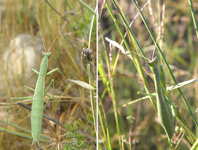Abstract
With approximately 2400 described species distributed worldwide (Ehrmann, 2002), praying mantises (Mantodea) exhibit extensive variation in morphological adaptations and life history strategies, typically in connection to their strict predatory habits. Praying mantis diversity is frequently under-appreciated, mostly because of their sedentary and highly cryptic lifestyle, often resorting to various forms of mimicry and mimesis, resembling sticks, flowers, tree bark, bird droppings, pebbles, moss, lichen, and green and dead leafs. Because of these attributes, they are difficult to collect and observe in the field. Certain aspects of praying mantis ecology, behavior and physiology have historically received more attention than others, though most studies focus on a handful of species from temperate regions (see Prete et al., 1999). In contrast, tropical regions (which hold the bulk of Mantodea biodiversity) have received limited attention by researchers, that attention often punctuated. Their apparent lack of economic importance, rarity in collections and the ongoing “taxonomic impediment”, have all conspired to impede taxonomic and evolutionary studies. The consequences of these deficiencies are far reaching. For example, the current dearth of detailed taxonomic treatments and identification keys prevent the accurate assessment of regional faunas (Rivera, 2010). Further, the lack of a solid taxonomic foundation precludes the formal documentation of relevant aspects of natural history, a discipline that has also faced a steady decline since the early 20th Century (Hampton & Wheeler, 2012), but nonetheless is fundamental for fostering scientific inquiry and hypotheses formulation. The diversity of ecological strategies and adaptations of mantises, their role as predators, and their well-known (but little understood) cannibalistic sexual behaviors, make of these charismatic insects also outstanding model organisms to explore broader questions in ecology and evolutionary biology.

